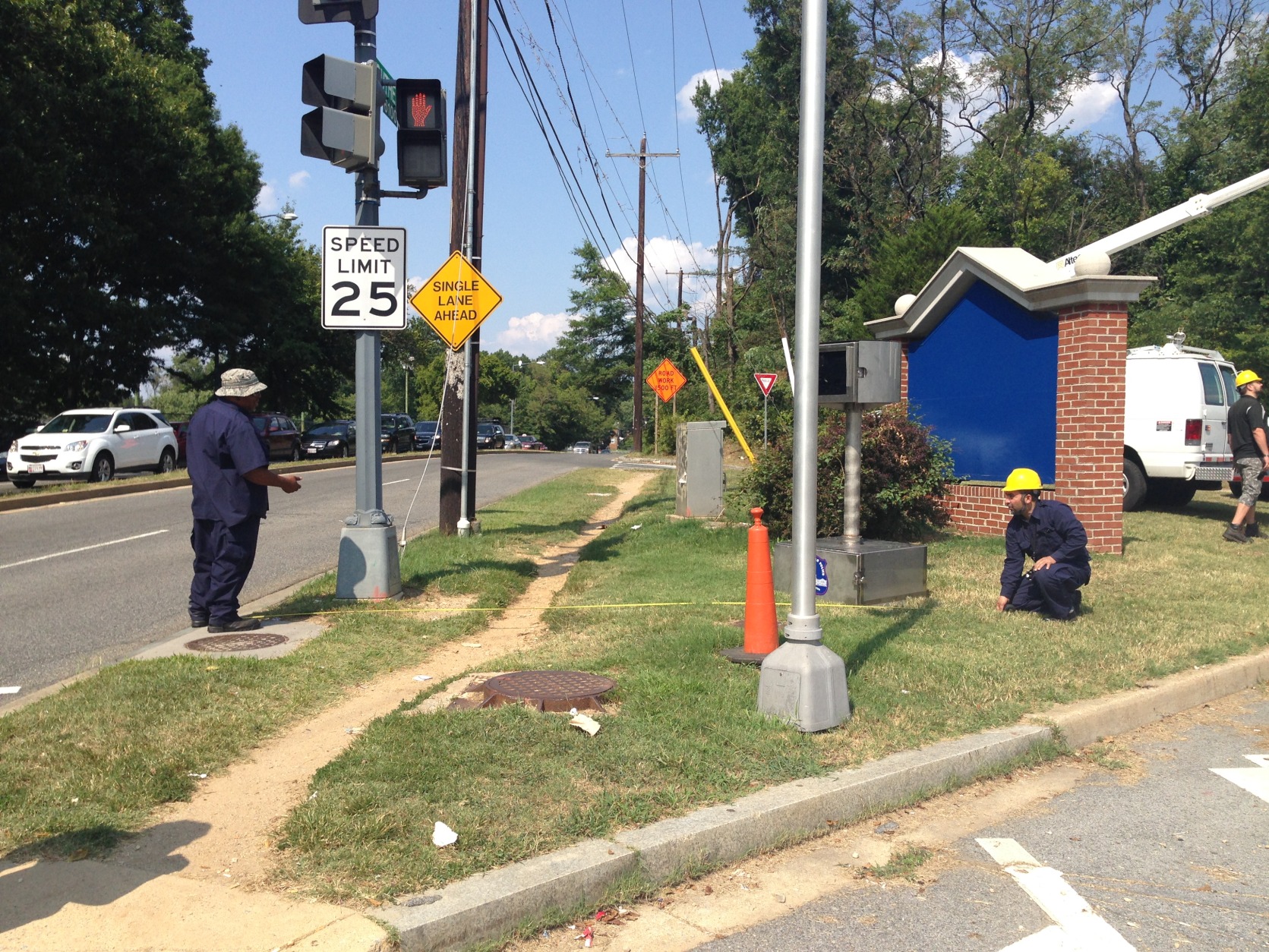
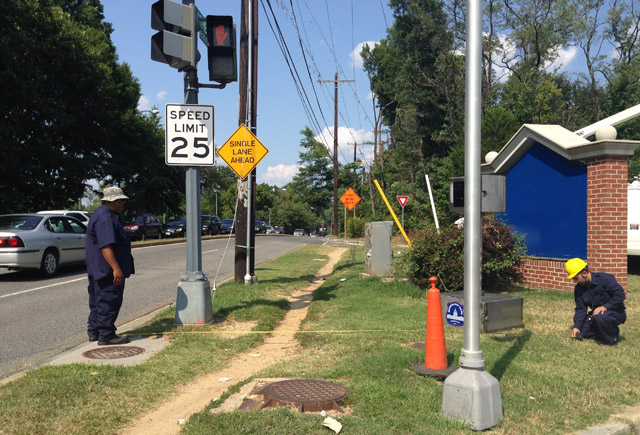
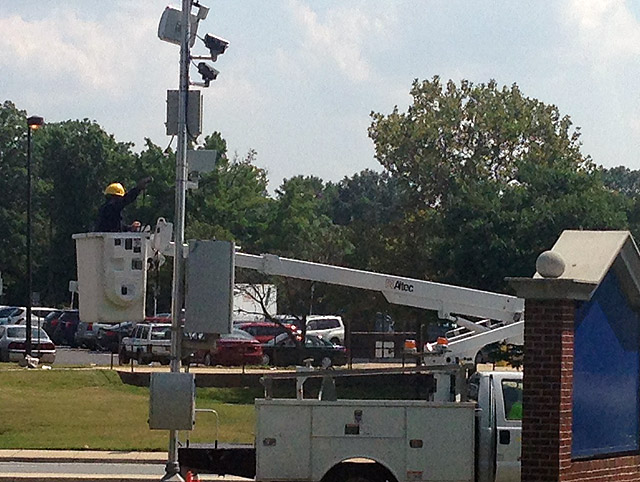
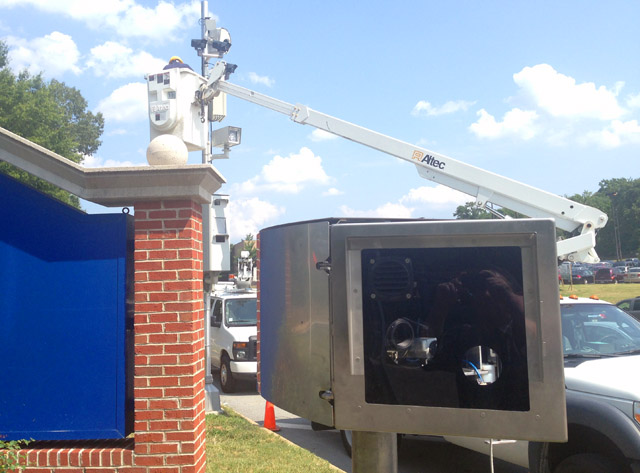
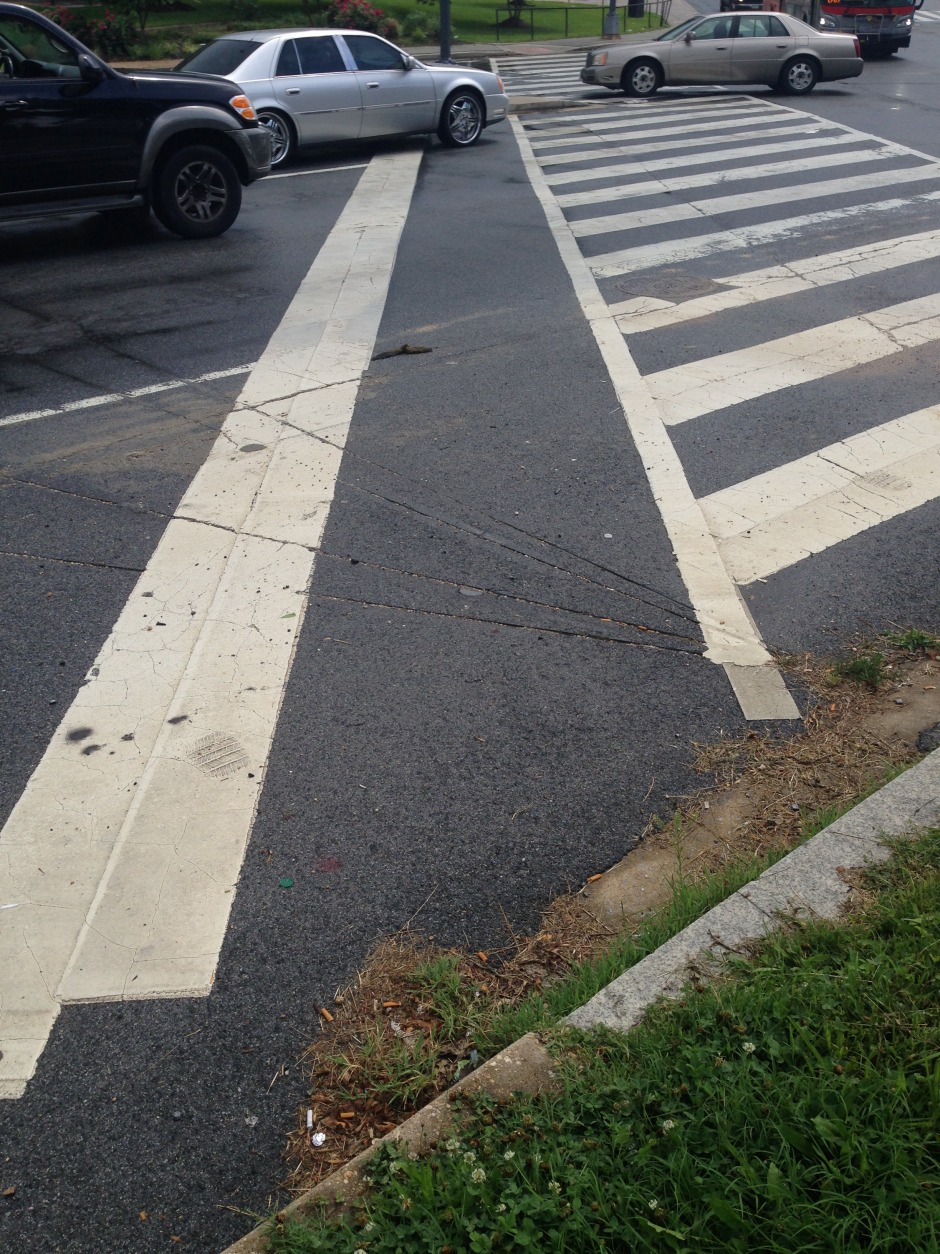
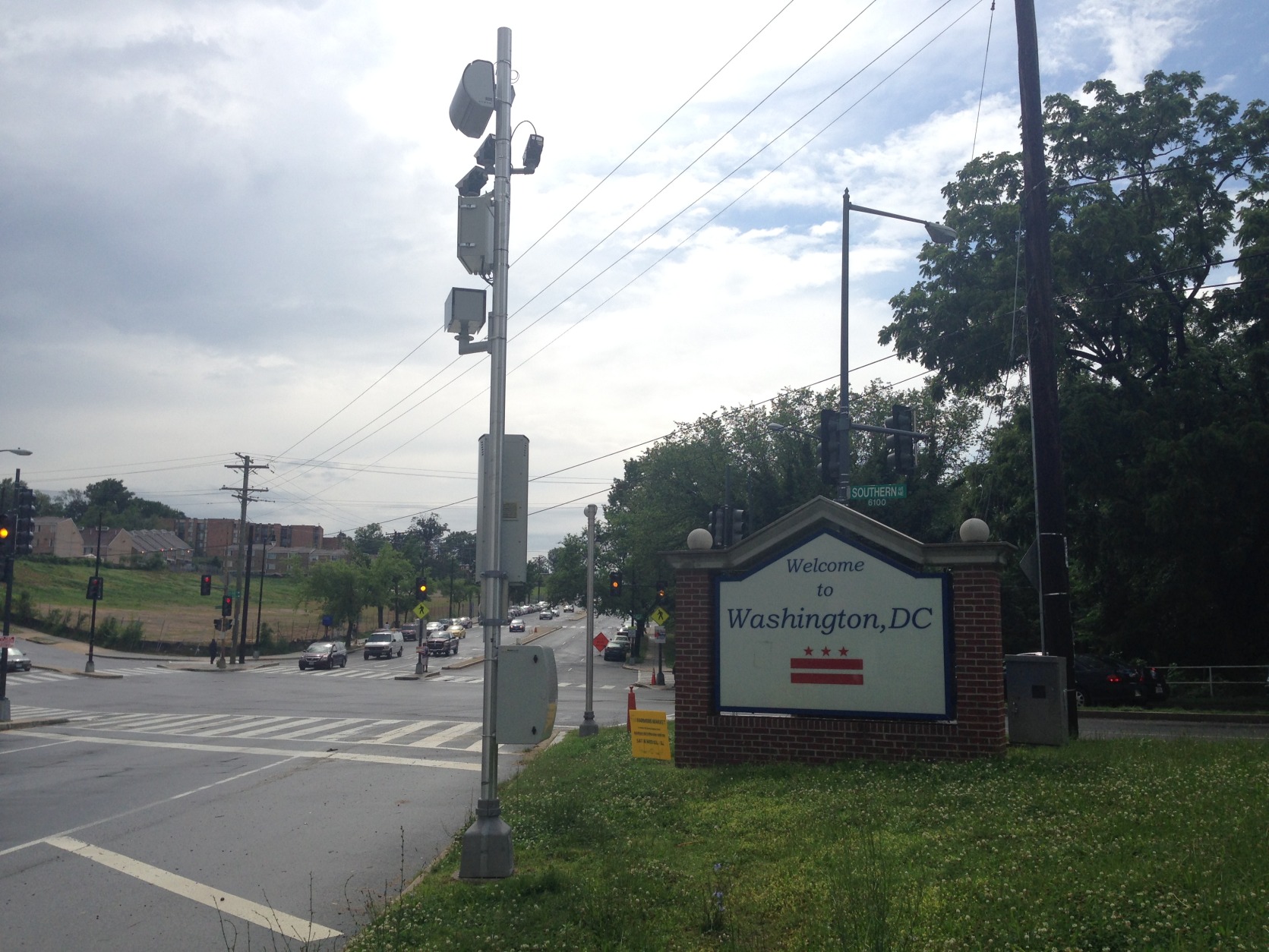
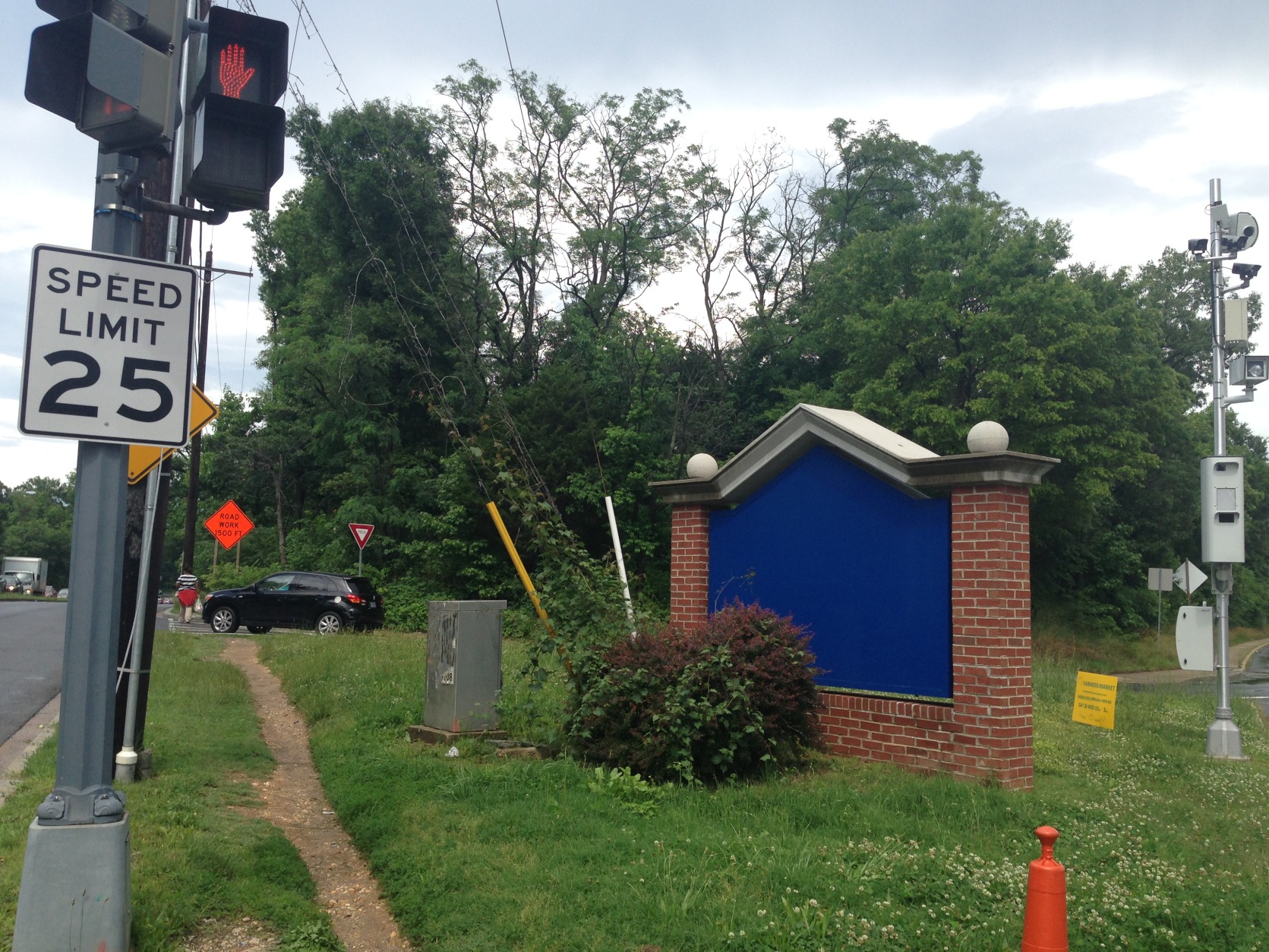
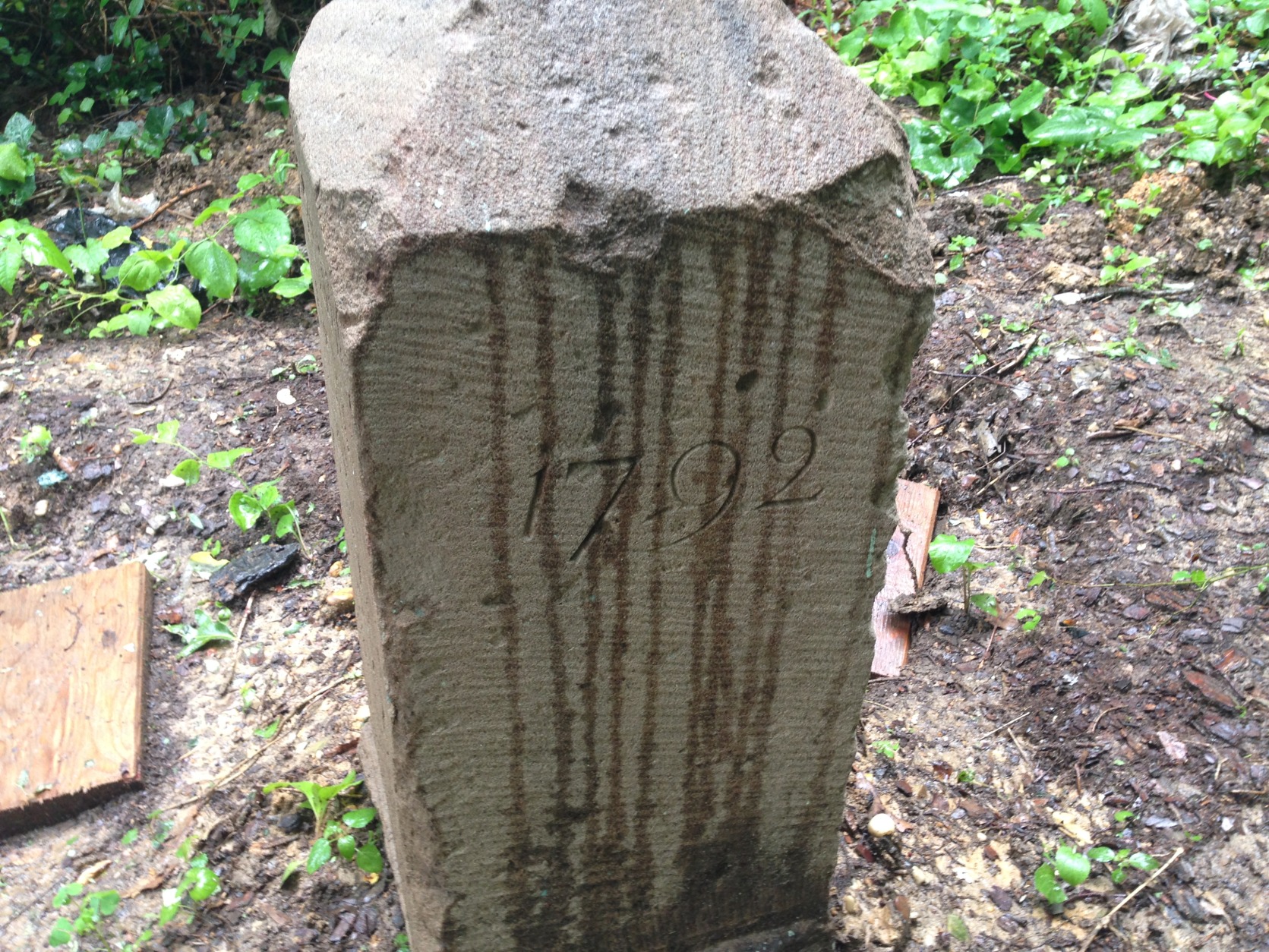
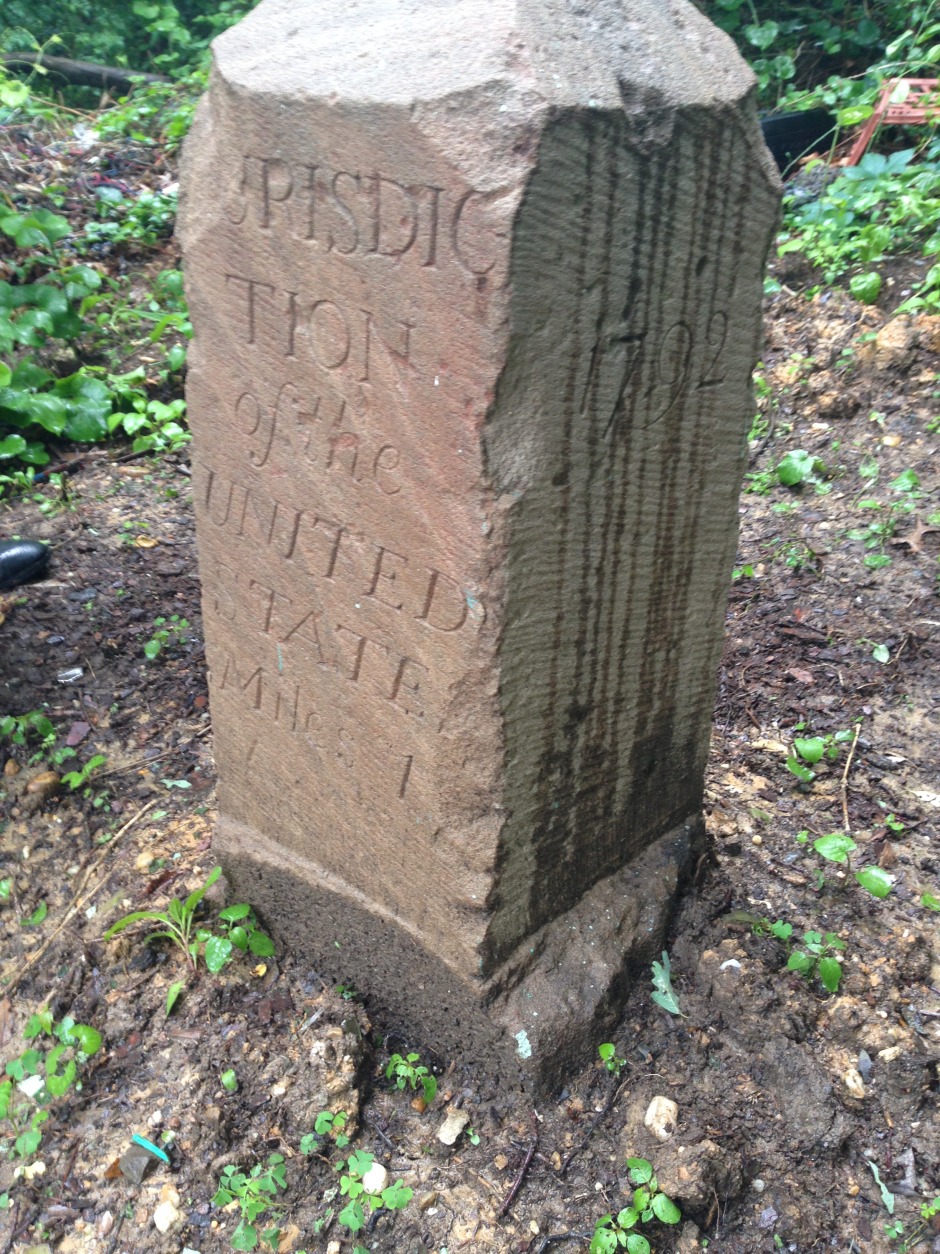

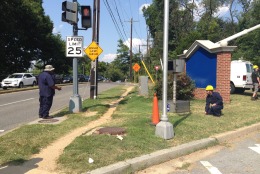
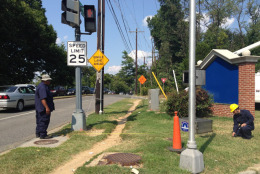
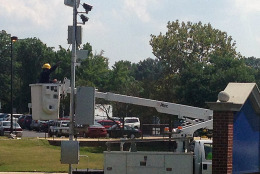
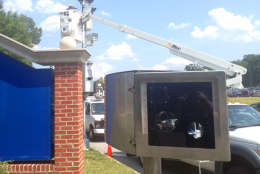
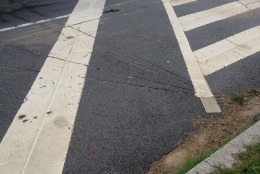
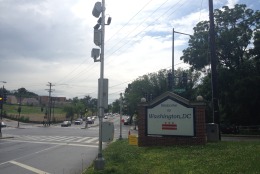
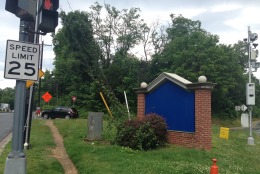
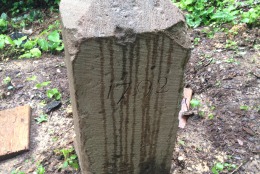
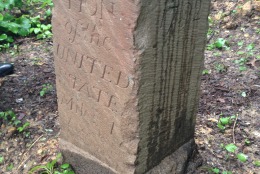
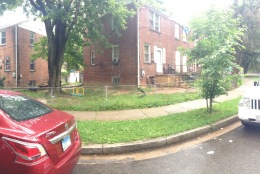
UPDATE: Tuesday, 8/5/2014, 11:20 p.m.
WASHINGTON — DC police have removed the intersection speed camera on a pole in Maryland. Crews set up a portable speed camera on the same triangular grass median strip, but on the D.C. side of the border. As previously reported, the D.C.-Maryland border extends about 18 to 20 feet from the Southern Avenue curb east into the grass. Engineers pulled out a tape measure to check various angles from the curb to ensure it complied with the border before leaving.
“Chief Lanier directed me to replace this older speed camera unit with a new portable unit several months ago, upon receiving this inquiry. Today, we have upgraded our speed camera configurations to a single portable unit system. Speed is still an issue at this location and we will continue enforcement there as we have in the past,” Assistant Police Chief Lamar D. Greene tells WTOP in a statement.
“We have been in contact with Maryland State Highway Administration in an attempt to locate historic documents in reference to this site. We will continue to work with them on this matter,” he adds.
Sources have given conflicting information to WTOP about whether D.C. officials ever got permission from Maryland SHA when the red-light camera was put up in 1999. The D.C. police did not move the red-light camera Tuesday, which remains active on the same pole where the speed camera was.
Meanwhile, WTOP and AAA Mid-Atlantic have now found a cornerstone that was previously lost at Eastern and Southern Avenue, known as mile marker 0. It is about 50 feet into the woods, surrounded by a small fence that was recently erected.
␎ 
We finally found the cornerstone mile marker 0 — the start of all borders. (WTOP/Ari Ashe)
EARLIER: Tuesday – 8/5/2014, 5:29am ET
CAPITOL HEIGHTS, Md. — New traffic cameras installed over the last year in D.C. are now ticketing drivers for red-light running, speeding, blocking the box and more.
However, a WTOP Ticketbuster investigation has uncovered one of those cameras was placed in Prince George’s County, Maryland, which could be illegal under D.C. law.
During a months-long investigation, D.C. officials have not denied the camera might technically be sitting in Maryland, yet they dispute the suggestion that it violates D.C. law.
The speed camera is where East Capitol Street, Southern Avenue and Central Avenue converge near the Capitol Heights Metro station.
Joanne Brown, of Bowie, brought the issue to WTOP Ticketbuster and AAA Mid-Atlantic after receiving three tickets from the camera.
“I always thought the line was somewhere in the middle of the road on Southern Avenue. If this is Maryland, and that corner is D.C., how can you go another block and it’s Maryland, then go another block it’s D.C. again, and another block it’s Maryland again?” says Brown, describing the confusing drive on Southern Avenue between East Capitol Street and Eastern Avenue.
The camera is in a triangular grass median separating westbound traffic crossing into D.C. from those turning right to go northeast on Southern Avenue.
Since 1999, there has been a red-light camera on the pole, but the D.C. Department of Transportation and the Metropolitan Police Department only recently added a new intersection speed camera.
Brown wanted to know: Is the camera in D.C. or Maryland?
AAA Mid-Atlantic assisted WTOP Ticketbuster in the investigation.
“The traffic signal is in the District of Columbia. The sidewalk is in the District of Columbia. The street in question is in the District of Columbia, but the camera itself is in the state of Maryland,” says John Townsend, manager of government and public affairs at AAA Mid-Atlantic.
His conclusion is based on U.S. history. In 1791, President Washington ordered Benjamin Banneker to conduct a survey and lay down corner stones to denote the borders delineating D.C., Maryland and the Commonwealth of Virginia.
A cornerstone remains near Southern Avenue and D Street Southeast, which D.C. surveyors believe is an original stone from 1792. Another is believed to be at Eastern and Southern Avenues, but it hasn’t been because it’s buried deep within the woods.
“You have to connect the dots from the stones. And what the dots tell us is that what’s happening here is illegal because the camera is in Maryland,” Townsend says.
According to a law enforcement agreement between MPD and the Prince George’s County police, the border extends about 18 feet from the curb at East Capitol Street and Southern Avenue. The document, obtained by WTOP Ticketbuster, is known as a “drop dead” document, which is meant to clarify which state has jurisdiction when a body falls on the border.
Other D.C. documents put the border at approximately 21 feet from the northeast curb.
Official Banneker stones put the border at approximately 20 feet, according to the D.C. Office of the Surveyor.
The intersection camera is 40 to 41 feet from the curb, putting it about 20 feet into Maryland. Other maps and surveys from the D.C. Office of the Surveyor and the Maryland State Highway Administration confirm the findings.
Is D.C. breaking the law?
WTOP Ticketbuster approached DDOT lawyers to ask whether it had a survey to dispute these results. The agency could not find any such documents.
Nevertheless, the agency reiterated MPD’s position that the speeding violations themselves were occurring in D.C. WTOP’s investigation found that conclusion is correct.
But does that mean MPD can place a speed camera in Maryland, as long as the vehicles are in the District of Columbia?
Two independent lawyers reviewed D.C. code and believe the answer is no.
“There are several statutes on this issue. But they all discuss automated traffic enforcement units in the District. That’s the phrase: ‘In the District.’ So the cameras are placed in Maryland illegally,” says lawyer Timothy Leahy.
“D.C. statute 50- 2209.11 states that ‘automated cameras “should be deployed in the District”‘ … To put them in Maryland is illegal. The District can try and explain this away, but it’s supposed to follow the law,” says lawyer Paul D. Hunt.
But the D.C. Office of the Attorney General and the police disagree with the lawyers’ conclusions.
“We believe that the validity of evidence of a traffic violation is not dependent on the location where a photograph is taken. In other words, accurate photographic evidence from outside of D.C. can be used to prove a violation in D.C. It is the location of the violation that is significant,” writes OAG spokesman Ted Gest.
“The law cited by WTOP’s sources relating to deployment of cameras in D.C. was from 2013 and is not relevant to a camera installed in 1999,” Gest’s letter concludes.
The 2013 law authorized the city to expand the camera program by adding a new speed camera on top of an existing red-light camera. The city argues that since this camera was added on top of a red-light camera that’s been active since 1999, the new law doesn’t apply.
However, it is the 2013 law that authorized the police to add intersection cameras, as well as blocking-the-box and other cameras, across the District.
Hunt argues the city isn’t directly addressing the issue in its response.
Last April, Mayor Vince Gray submitted a plan to the City Council to expand the program to include intersection speed cameras. That plan also uses the same language.
“The units are movable and will be attached to power poles, existing red light cameras, or batteries throughout the District,” says the plan.
Also, when DDOT released an exhaustive speed camera study in February, it divided new cameras into existing, planned and proposed. This camera was listed under the “planned” category.
Lawyers also tell WTOP Ticketbuster that D.C.’s own statute contradicts the attorney general’s position. They argue the statute makes it clear that the location of the hardware is what matters, not where the violation takes place.
“The term ‘automated traffic enforcement system’ means equipment that takes a film or digital camera-based photograph which is linked with a violation detection system that synchronizes the taking of a photograph with the occurrence of a traffic infraction,” it reads.
Brown wonders what would happen if the reverse occurred.
“Do you think D.C. will let Maryland post one of their cameras in D.C.? That’s the question I guess we need to ask D.C.,” she says.
An analogy
One D.C. source, who asked not to be identified, compared this situation to a D.C. police officer crossing the street into Prince George’s County to enter a convenience store, then exiting and witnessing a crime occurring back in the District.
This source pointed out that the officer is allowed to arrest the suspect and testify under oath about what the officer witnessed while in Prince George’s County, as long as the crime occurred in D.C.
But is this analogy accurate?
“The problem with that analogy is that the D.C. police officer can cross the line legally, can stand in Prince George’s County, can stand in D.C. The camera isn’t there legally. The officer is temporarily in Maryland. The camera is always sitting in Maryland,” Leahy says.
“I think the law is clear-cut, but that’s different than asking me: Can reasonable people disagree? I think reasonable people can disagree on this issue,” he adds.
Hunt says the circumstances aren’t the same as a hot pursuit.
“If this were a hot pursuit that would be one thing. But you cannot make the case that automatic traffic enforcement falls under hot pursuit guidelines that would allow police officers to cross borders to track down a suspect. The analogy is not completely accurate,” Hunt says.
What do you do if you get a ticket?
Those who get tickets from the camera in question have a few options to fight the issue, although each would be time-consuming and potentially expensive.
First, you can contact lawmakers. Ward 7 Councilwoman Yvette Alexander represents the area in the District. Sen. Joanne Benson, D-Prince George’s, and Del. Carolyn Howard, D-Prince George’s, represent the area in Prince George’s County in the General Assembly.
Representatives for Alexander, Benson and Howard did not respond to multiple requests for comments on the investigation.
However, Councilman Tommy Wells addressed the issue. He oversees MPD on the City Council.
“In the event that the issue is not resolved, the Committee on the Judiciary and Public Safety will look into it further. However, at this point, this is an issue most appropriately handled by the Chief and her staff in coordination with the Department of Transportation,” Wells writes in a statement.
You also can fight the ticket in the legal system.
Traditionally, you must go before the D.C. DMV to adjudicate any speed or red- light camera ticket.
“You would go before a hearing examiner and make the case that the system is deployed in Maryland. This counsel thinks your defense will be denied at the earliest stages because they’re not going to make a pronouncement about citywide policy. So you’d essentially have to go through a long road to the D.C. Court of Appeals before a decision was made,” Hunt says.
But such a process would take at least two years, perhaps more.
“Another option would be filing for an injunction. You need to have standing with a pending ticket, but if you filed in D.C. Superior Court for an injunction to shut down the program camera, then you’d certainly get the city’s attention,” Leahy adds.
This process would also be time-consuming and complicated.
“Unless you can do it yourself as a lawyer, you’re talking about 100 hours of legal time and could spend as much as $20,000 with no guarantees of success over a $100 ticket,” adds Hunt.
The final option would be a class-action lawsuit, but that would also require time, money, lawyers and a number of plaintiffs with pending tickets who join together.
“If I don’t go through with it, a lot of other folks won’t. That’s how they’re getting away with crap like this. But I will probably will be dead by the time that a judge decides to do something about it,” Brown says.
A panoramic shot shows where Southern Avenue meets Eastern Avenue. The cars and homes are in D.C., but the other side of the street is Prince George’s County. The Banneker cornerstone at mile marker 0 is buried deep within the woods, lost to history.
D.C. Office of the Surveyor (1)
A construction survey of the intersection from the D.C. Office of the Surveyor. The handwriting on the survey lists the border as about 20 feet from the intersection.
D.C. Office of the Surveyor (2)
If you think you’re the victim of a bogus speed camera, red-light camera or parking ticket in D.C., Maryland or Virginia, WTOP may be able to help you cut the red tape. Email us your case — along with documentation — to ticketbuster@wtop.com.
Follow @WTOP and @WTOPTraffic on Twitter and WTOP on Facebook.







